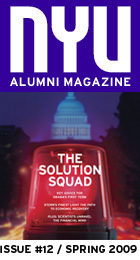What were they thinking?
Two scientific subdisciplines may offer future clues to financal collapse
Brightly colored blobs of swishing, glowing matter: This is your brain on economics.
Or, more accurately, this is the view of your brain that interests researchers in the controversial, infant science of neuroeconomics. It is a field evolving at the intersection of psychology, neuroscience, biology and economics—a melding that was little imagined even five years ago, before the advent of sophisticated brain-scanning technology. And, along with behavioral economics, which considers irrational behaviors that classical economic theory can’t explain, its practitioners are pursuing novel lines of research that might one day unravel the decision-making that informs investing, saving, insuring, and the way government regulation works.
Mapping financial decisions
Neuroeconomics, in a nutshell, is the study of different brain regions that kick into gear when people make economic decisions, which are now observable with functional magnetic resonance imaging (fMRI). Blood flow is visibly greater in one area when we learn under stress, for example, and in another when we weigh risk, and in yet another when we assign value to something. Along with the California Institute of Technology, NYU is the global center of this research, and recent studies here have found differences in brain response when a decision involved novelty, ambiguity, or deep emotion.
Neuroeconomics, of course, has its detractors. At conferences and in scholarly journals and books, critics have questioned—sometimes heatedly—the compatibility of the disciplines, holding that neural science and economics have different goals, ask unrelated questions, and explore different types of evidence. In fairness, it’s still not clear exactly how much we can extrapolate from images of blood flow. But while economics departments are yet to grant degrees in the field, a leader in the discipline, Paul W. Glimcher, principle investigator at the Center for Neural Science at NYU (whose 2008 book, Neuroeconomics: Decision Making and the Brain, was the field’s first), suggests that this research will one day be as useful to economists as biologists now find chemistry and physics.
A step in this process is to understand the role of emotions in decision-making. Elizabeth A. Phelps, a professor at the Center for Neuroeconomics at NYU, is currently investigating the relationship among arousal, fear, and economic choices. Phelps won’t generalize about how her lab’s findings speak to the current crisis—“We aren’t even close to mirroring the situation in the markets,” she cautions—but it seems neuroeconomics may one day help explain the underlying emotions that recently drove euphoric speculators, risky borrowers, aggressive lenders, or timid regulators. The economy’s implosion has already sparked fresh interest from academics in joining the center’s cross-disciplinary collaboration, Phelps notes. People realize that they need to understand bubbles, she says, and to learn how policymakers’ emotions “might mediate changes in decision-making that we see in crisis times.”
These heated emotions are also the issue of the moment for another NYU neuroeconomist, Andrew Caplin, an economics professor in the Faculty of Arts and Science and co-director of the Center for Experimental Social Science. Bridging traditional and experimental economics, he co-authored a chapter on mortgages in the Stern School’s book and, on the neuroecon front, he’s working on improving the new discipline’s methods.
Caplin believes getting to the bottom of the neurological basis of economic decision-making matters because, just to cite one application, currently much of America’s rapidly aging population isn’t taking the necessary financial planning steps to ensure their security in old age. He also says that there are ways the science could be useful to policymakers in Washington, to help them better understand the biological roots and impact of stress: “We need nonemotional analytic clarity to prevent another [crisis] event. Policymakers, as human beings, undergo naturally dangerous responses to stress. Right now they are overwhelmed and their decision-making facilities are extremely impaired.”
Behavior Matters
That other useful subdiscipline, behavioral economics is a hybrid of economics and psychology, and aims at answering questions neoclassical economics can’t: How can humans be rational when we’re so easily confused, prone to failures, and bad at figuring out our own best interests, whether in a prescription drug plan or a retirement savings vehicle? (American borrowers certainly couldn’t figure out how much mortgage they could afford.)
One important area of inquiry is looking into why investors’ tend to swing wildly between being overly fearful and unrealistically hopeful. This is the specialty of Leonard N. Stern School of Business finance professor Jeffrey A. Wurgler, whose behavioral finance research looks at stock market crashes. In the past year, stocks have fallen 50 percent and classical finance would argue it’s because future corporate profitability looks to be that poor. But Wurgler points to investor sentiment instead. By taking a big-picture view of investor sentiment in a number of nations, measuring patterns and markers of bubbles, Wurgler has concluded that overreaction, on the upside and the way down, explains the plunge’s severity. A self-reinforcing cycle of ever-rising expectations creates bubbles, and then they burst.
Compared to the fledgling neuroscience, behavioral economics is pretty well established. The field grew popular in the 1990s and some say it’s reached faddish proportions today. Wurgler notes that fund managers are already embracing behavioral finance insights to ferret out good buying opportunities. “I think [the field] will become more prominent as we sift through the aftermath” of the meltdown, he says. Next, regulators may follow suit by using these insights to, for example, curb speculation. They are now steadily backing away from the hands-off Alan Greenspan years, recognizing that financial institutions can’t be left to their own devices. And individuals? Consumers and borrowers in a free society can’t exactly be protected from themselves. But if there are ways to tweak the current state of affairs, behavioral economomists are likely to find it.








